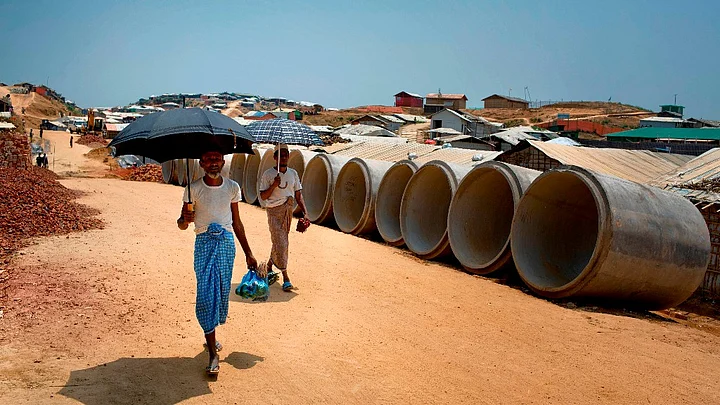The Rohingya refugees have escaped soldiers and gunfire. They have escaped mobs that stormed through their villages, killing and raping and burning. They have fled Myanmar, their homeland, to find shelter in sprawling refugee camps in neighbouring Bangladesh.
Now, there’s a new danger: rain.
The annual monsoon will soon sweep through the immense camps where some 700,000 Rohingya Muslims have lived since last year, when they poured across the border in search of safety. The clusters of bamboo and plastic huts, built along endless waves of steep hills, are now facing a deluge that, in an average year, dumps anywhere from 40 to 60 centimetres (16 to 24 inches) of rain per month.
Rahana Khatun, 45, who fled Myanmar last year with her husband and five children, said:
I will not be able to light a fire. The wells will flood and I won’t be able to get water. The outhouses will be destroyed. The house might also break down. What will happen to us?
“I have fled my country. I am grateful to Allah for the little I have here in Bangladesh,” she said. “But now the rains are coming and I am so worried!” she said.
Government authorities and aid agencies have warned of a catastrophe if there are heavy rains this year.
Occasional rains have already hit the camps this year, with the full monsoon expected in the coming weeks.
Aid agencies are now pre-positioning supplies across the camps, since flooding could easily block paths to food, water and medical care.
With most of the area's foliage long gone, stripped away by refugees looking for firewood, little natural protection remains against mudslides.
There are no more trees, no more roots, so there could be massive landslides, burying people that live at the bottom of the hills.Benjamin Steinlechner, UNICEF spokesperson
An even bigger worry is cyclones forming in the nearby Bay of Bengal.
Cyclones used to regularly kill thousands in Bangladesh, with the storms sweeping through low-lying areas and devastating everything in their path.
The Bangladesh Red Crescent Society estimates that at least 100,000 refugees will be exposed to extreme dangers during the monsoon.
"If there is a cyclone, there really is not much more we can do. People will be blown away, houses will be blown away. That's the risk everybody in the camp is facing right now,” said Steinlechner.
"We are reaching out to the people right now to make sure that they know where to go in case they find themselves in an emergency situation," he added.
Construction workers are building 200 new homes in part of the Kutupalong camp. The homes, funded by overseas donors, will have concrete floors, bamboo walls and tarpaulin roofs. Other workers are planting grass and trees around the homes to help prevent erosion and landslides.
But even those homes, some of the best for kilometers (miles) around, won't be able to withstand a major storm.
(This article has been published in association with the Associated Press)
(The Quint is now on WhatsApp. To receive handpicked stories on topics you care about, subscribe to our WhatsApp services. Just go to TheQuint.com/WhatsApp and hit send)
(At The Quint, we question everything. Play an active role in shaping our journalism by becoming a member today.)
